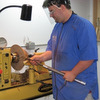I've shifted most of my turning tools to utilize removable handles, really liking the Robust Collet system. Before this i stored all my tools on the wall and it worked well for handled gouges, see pic. I'm looking for ideas on how to store unhandled tools, as the racks I have on the wall now don't make good use of space for unhandled tools.
Any thoughts, pics, or suggestions welcome.
IMG_0196.jpg





 Reply With Quote
Reply With Quote

